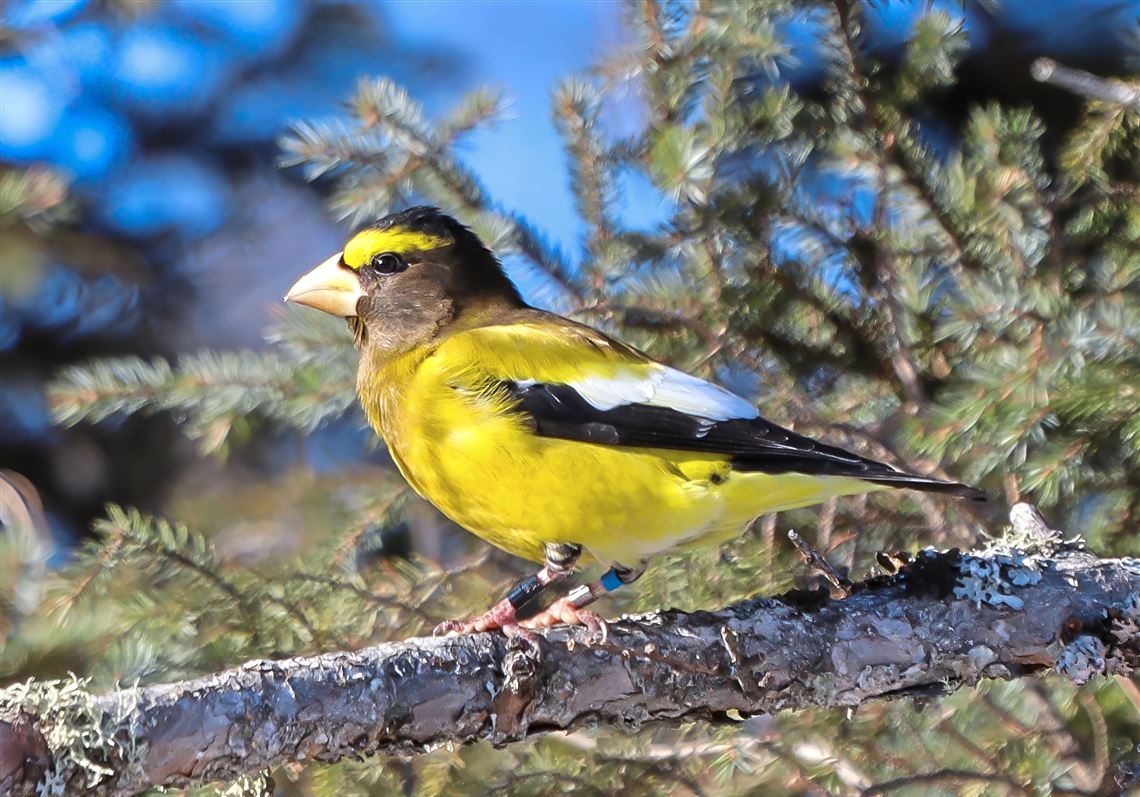As sightings go, it wasn’t the best: David Yeany was walking in Indiana Township in early November and heard the piercing call of a bird in flight for only 10 seconds, “peeer…peeer…peeer.”
Yet it was a personal, local and significant record of an evening grosbeak, one of the fastest declining birds in the nation. The grosbeak population has declined 92% from 1970 to 2014, according to a U.S. and Canadian wildlife agencies’ report, the Partners in Flight Landbird Conservation Plan.
Evening grosbeaks, which are black and gold with white wing patches, have become the rare superstars of backyard feeders. In winter, gregarious groups of them descend on bird feeders to feast on sunflower seeds, effortlessly cracking seed shells with outsized conical beaks.
Yeany can identify the grosbeak’s call without actually seeing it because he has been studying the bird for seven years.
Yeany is an avian ecologist for the Western Pennsylvania Conservancy and Pennsylvania Natural Heritage Program who studies evening grosbeaks with Powdermill Avian Research Center, the Finch Research Network and others.
He has spent many hours at his field station in the Allegheny National Forest in Forest County, where his bird feeders can attract flocks of up to 175 grosbeaks. The birds breed in the boreal forests of Canada and visit Pennsylvania from October through April.
They are beloved for several reasons, Yeany said. ”The grosbeaks are a type of natural pest management.”
One of their favorite foods are Eastern budworms, which can infest and kill fir trees.
“In addition to helping the ecology, they are a lovely bird to see at your birdfeeder,” he added.
In the last several years, Yeany’s research has gained traction and expanded nationally with funding from the Knobloch Family Foundation. The grosbeak’s decline has drawn increased attention from Road to Recovery, a national conservation group.
“To lose so many evening grosbeaks was a wake-up call,” said Kathleen Krafte Holland, a research scientist at Virginia Tech who is the conservation social science coordinator working with the Road to Recovery program.
The evening grosbeak ranked among about 70 “tipping point” species identified by Road to Recovery. These are birds on track to decline another 50% in 50 years if something doesn’t change, Holland said. The goal is to save the birds from the threatened and endangered species lists.
Yeany’s research is discovering everything scientists need to know about the biology of the grosbeaks, she said.
Suspected reasons for the bird’s decline are population cycles for budworms as well as window collisions, disease and habitat loss, Yeany said.
Trying to find out where grosbeaks go and their habits is no small feat.
Yeany has been tracking the birds’ movements with colored leg bands and outfitting the grosbeaks with what looks like tiny backpacks. Small, bird-size harnesses support satellite tags and nanotags – solar-powered tracking devices weighing less than one-tenth of an ounce.
The tracking devices are “incredibly small for what the tags can do – measure movement and migration for years,” he said.
Evening grosbeaks have a lifespan of about 15 years.
Yeany recently returned from Sax-Zim Bog in northern Minnesota to band and tag grosbeaks there. Earlier he worked on grosbeak tagging in Maine, New York and Pennsylvania.
“We want to understand more about the link between wintering birds, migration and breeding areas and what factors are influencing the decline of this species,” he said.
His research has found that many grosbeaks banded in Western Pennsylvania travel about 620 miles, one way, to nest in Quebec, Canada.
Yeany is asking people in the region to report spotting any grosbeaks with color-coded bands on their legs or tags.
“By people reporting their sightings, that gives us another data point,” he said.
“The birds move around a lot during the winter time. If they move a lot to get their food, they open themselves to more vulnerabilities, similar to when a person drives a car around a lot. The chances of a crash increase.”
While Holland admits it’s difficult to get people to care about a single species, people do have the desire to do something worthwhile and can help by simply reporting a backyard sighting of the evening grosbeak to Yeany’s research group or eBird.
Email reports of grosbeaks with colored leg bands or photos, with dates and locations, to Yeany at dyeany@PAconserve.org. To donate to Yeany’s research, visit bit.ly/3z2qN6U.
More information
Western Pennsylvania Conservancy: waterlandlife.org
Road to Recovery on declining birds: r2rbirds.org
Road to Recovery on evening grosbeaks: r2rbirds.org
Submit bird sightings electronically to the Cornell Lab of Ornithology: secure.birds.cornell.edu
First Published: March 22, 2023, 10:00 a.m.
Updated: March 22, 2023, 10:16 a.m.
















